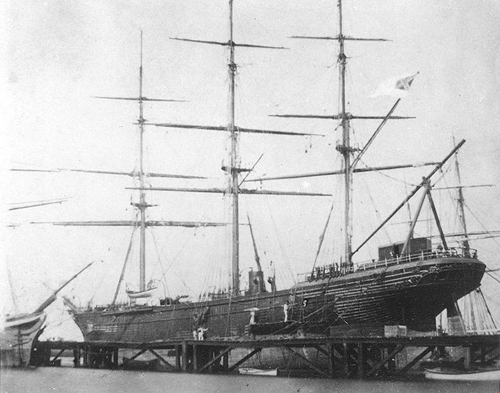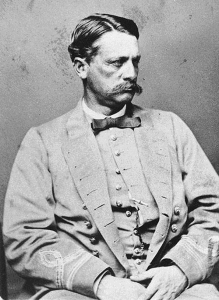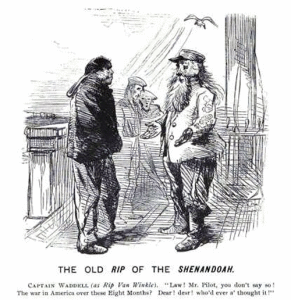
CSS Shenandoah while undergoing repairs in Melbourne, Australia in 1865. Picture courtesy of the U.S. Navy Historical Center.
This year marks the 150th anniversary of the end of the Civil War, which was fought from April 12, 1861 to May 26, 1865. As a young boy who read many history books, I remember reading a story about a Civil War ship that kept on fighting after the war was over. This is that story:
The Civil War started after eleven of the then thirty-four states withdrew from the United States and formed their own country. Texas was one of the eleven “Southern” states, and a new country was formed known as the “Confederate States of America”. The remaining states in the United States were known as the “Union”. While I’m not going to go into the causes or reasons behind the Civil War, it was a bloody conflict, with over 850,000 troops on both sides killed. In some instances brothers, fathers & sons, and other family members fought against each other on the opposing sides. When the war ended, the Union had won and the United States was changed forever.
The Confederate Navy had only fourteen ships in service at the beginning of the Civil War verses the ninety ships in service with the Union Navy. The Confederate Navy remained at a disadvantage throughout the war and at times ended up purchasing ships from foreign nations. James Bulloch was the Confederate Navy’s purchasing agent in Great Britain and happened to be the uncle of future U.S. President Theodore Roosevelt. In September 1864, Bulloch arranged for the purchase of a ship named the “Sea King”. The Sea King was a sailing ship that also had a steam engine that powered a propeller.
As Great Britain was a neutral country, the Sea King could not be outfitted or put in service as a warship, so the Sea King set out on a “trading voyage” to India. This was a lie, as once the ship was off of Portugal, she met up with another ship carrying cannons, ammunition, and supplies. On October 19, 1864 the ship was commissioned as the CSS (Confederate States Ship) Shenandoah under the command of James Iredell Waddell of North Carolina. Waddell had previously been in the U.S. Navy for some 20 years. Waddell’s orders were to attack Union shipping and the New England whaling fleet.
From the start the CSS Shenandoah was hampered by a lack of crewmen. Waddell needed 150 crewmen to properly crew the ship, but started out with only 43 counting the officers. Most of the original Sea King crew returned to Great Britain with the supply ship, wanting no part in the war despite offers of gold coins and two months extra pay. While mounting the guns it was found that the tackles for resetting the guns after firing were missing. Despite these problems the Shenandoah set sail, finding her first victim nine days later, a cargo ship from Maine named the Alina. From the Alina, Waddell got the missing tackles for the guns, extra sails, managed to recruit seven crewmen, and then the Alina was sunk. In the following twelve days the Shenandoah captured and sunk two more ships, taking the crew prisoner, getting what cargo they needed, and sinking the ships. Most of the prisoners from the captured ships were dropped off with a Danish ship they encountered. Sailing South along the Coast of Brazil in the Atlantic Ocean, Waddell and the Shenandoah captured and sank three more ships by the end of December 1864, gaining nine more willing crewmen. News in the United States finally reported on the presence of the Shenandoah and two Union warships were sent to find her; the USS Iroquois and USS Wyoming.
After encountering a problem with the Shenandoah’s propeller that could not be fixed at sea, Waddell would have to find a friendly port for repairs. Using the Shenandoah’s sails, Waddell sailed east into the Indian Ocean around the southern tip of Africa and arrived at Melbourne Australia on January 25, 1865. The Shenandoah was allowed into the harbor to make repairs against the protests of the U.S. Consul there; William Blanchard. The officers and crew of the Shenandoah were welcomed by the citizens with open arms, with numerous dinner parties, and dances being held in their honor. Blanchard tried another ploy; he stated that any of the crewmen from the Shenandoah who had joined from one of the captured ships and wished to give themselves up to his office, would be “safe”. Fourteen crewmen took him up on this offer further depleting the crew. For the three weeks the Shenandoah was in Melbourne, Blanchard constantly accused Waddell and his crew of wrongdoings, namely trying to recruit crewmen from the local population.
With repairs complete, the CSS Shenandoah departed Melbourne on February 18, 1865. Once outside of Australian waters, 40 new crewmen mysteriously emerged from within the ship and were signed on as part of the crew. Sometime after the first of April near the Caroline Islands in the Pacific Ocean, Waddell and his crew found four whaling ships and sank them after capturing the crews. Per the norm, seven crewmembers from these ships were persuaded to join the Shenandoah. The rest of the captured crewmembers were set ashore. Waddell then sailed the Shenandoah North along the Russian Coast towards the Sea of Okhotsk looking for the New England whaling fleet. The whaling ship Abigail was captured and burned on May 27, 1865. Fourteen additional crewmen were recruited from the Abigail, along with a supply of alcohol some of the Shenandoah crew managed to sneak aboard. Unknown to Waddell and his crew, Confederate General Robert E. Lee had surrendered his Army on April 9, 1865 to Union General Ulysses S. Grant. Confederate President Jefferson Davis was captured on May 10. By May 26, 1865 all of the Confederate forces had surrendered and the Civil War was at long last over.
But news in the 1860’s did not travel fast at all. It’s hard to believe there was a time when news could take days, weeks, or even months to travel around the world. Waddell and the Shenandoah proceeded into the Sea of Okhotsk and after the Civil War had ended, decimated the New England whaling fleet, capturing twenty whaling ships. Most were sunk, with three of the ships spared to transport the prisoners. Two of the whaling ship captains told Waddell that they had heard the war was over. Waddell asked for proof, but none was available. When the whaler Nimrod was captured, the captain, James Clark, was shocked to see Shenandoah officer Smith Lee leading the boarding party. Lee had been on the CSS Alabama which had captured and sank Captain Clark’s previous ship in 1863.
The news broke on June 20, 1865 in San Francisco about the CSS Shenandoah and the destruction of the whaling fleet. A panic broke out as there were no Union warships present. The news was sent to Washington D.C. and plans were made to convert some commercial ships to warships to pursue the Confederate raider. On June 27, 1865 Shenandoah captured the whaler “Susan & Abagail”. The Captain showed Waddell a San Francisco newspaper describing General Lee’s surrender and the evacuation of the Confederate Government from Richmond. However, the newspaper also contained Confederate President Jefferson Davis’s proclamation that “the war would be carried on with renewed vigor”.
Waddell then proceeded towards San Francisco to attack the city as he correctly believed it would be weakly defended. On August 2, 1865 the Shenandoah encountered the British ship “Barracouta”. A stack of recent newspapers were brought on board which revealed that the Civil War was indeed over, the ship and crew was now without a country. Waddell ordered the guns dismounted and stored below decks, the Confederate Naval Flag was lowered, and the ship was painted to resemble an ordinary cargo ship. Waddell decided to surrender the ship in Great Britain as he correctly assumed he would be charged with piracy and hanged if he surrendered at a U.S. port.
The CSS Shenandoah sailed from the west coast of the United States, around the southern tip of South America, to Liverpool England, a voyage that took three months and over 9,000 miles while being pursued by Union warships. In total the Shenandoah had been at sea for 12 months and 17 days, had travelled around the world 58,000 miles, and sank or captured 38 ships, mostly whalers.
The Shenandoah finally arrived at Liverpool on November 6, 1865. As the ship was not flying a flag, the Shenandoah was refused entry to the harbor by the pilot boat that came out to escort the ship in. So up went the Confederate Naval Flag for the last time and the Shenandoah entered the Harbor and surrendered to the HMS Donegal. After the surrender the crewmembers were questioned about which country each of them had come from, as piracy charges could still have been brought against them in Britain if found to have not been from the United States. Each replied that they were from the “Southern States”, and disappeared into the city as they were released. A Liverpool newspaper reported at the time that “Several of the crew, who purported to be Americans, had an unmistakably Scotch accent, and seemed more likely to have hailed from the banks of the Clyde than the Mississippi”.
Several of the Shenandoah officers did not return to the United States for years. James Waddell returned from England to the United States in 1875 to captain a ship for the Pacific Mail Company. He later was in charge of the State of Maryland’s oyster regulation force, Waddell died in 1886. A new guided missile cruiser, the USS Waddell DDG-24, was named after him in 1964.
James Bulloch, the Confederate purchasing agent in Great Britain, never returned to the United States. In the 1880’s Theodore Roosevelt persuaded his uncle James to write an account of his activities during the Civil War. Bulloch died in Liverpool in 1901 at the age of 77. His tombstone bears the inscription: “An American by birth, an Englishman by choice”.
The Shenandoah was turned over to the United States, was sold in 1866 and later sank in the Indian Ocean in 1879. Shenandoah’s Confederate Naval Flag was preserved and has been on display in Richmond Virginia at the Museum of the Confederacy since 1907.
Newspaper Quotes are from the Liverpool Mercury Newspaper for Tuesday 7th November 1865. Assistance with the writing of this article must be credited to the U.S. Navy Historical Center, numerous other written sources, and my editor; Gaylen Youngblood.


